9 American Popular Music
Introduction
Popular music is by definition music that is disseminated widely. As such, it has been particularly significant with the twentieth-century proliferation of recording technologies and mass media. Sometimes we may forget that it was not until the 1920s that widespread recording and playback technology allowed for the spread of music through records. To become popular before that time, a tune had to be spread by word of mouth, by traveling performers, and by music notation, which might appear in a music magazine or newspaper or in sheet music that could be bought at general stores, catalogs, and music stores.
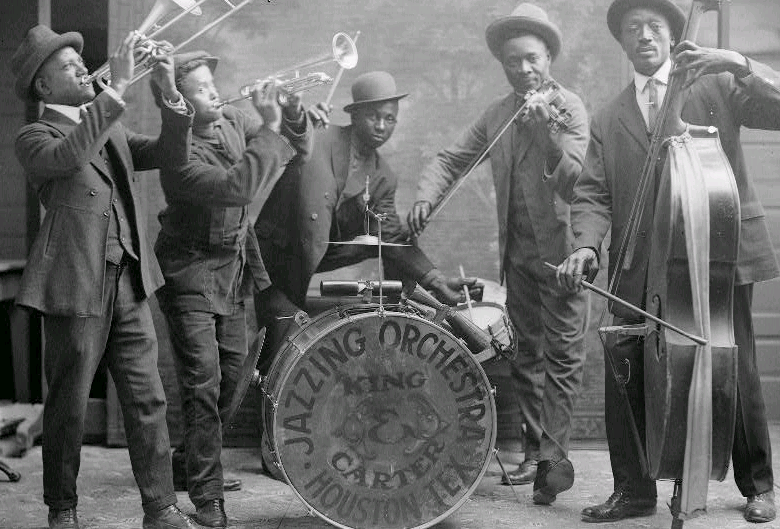
In our previous units, we’ve been fortunate to have a wide variety of openly licensed listening examples – music that is in the public domain (it’s so old it no longer falls under copyright) or that the musicians have allowed to be freely shared. In lieu of many available openly licensed listening examples, Chapters 9 and 10 are supplemented with additional “bonus videos” from YouTube. In Chapters 9 and 10, the vast majority of listening examples are not openly licensed and free to share, as we’re studying music that’s, generally, not old enough to fall into the public domain. We’ve provided YouTube links, and many, if not all, of these pieces can be freely accessed directly from providers like YouTube and Spotify.
Today the success of a popular music artist is most often measured by how many songs they sell. In the past, that meant record and CD sales, but today it essentially means the number of downloads. Recording industry executives determine which artists to record and distribute based almost entirely on their perceived ability to sell units. Most popular music today is sold by downloading it to an electronic device, though CDs (and even record albums) are still manufactured and distributed.
Popular music is also often thought of as ephemeral, that is, as remaining in the consciousness of a group of people for a limited time. For this chapter, we have chosen popular music that has either transcended that boundary or that was so important in or exemplary of its time and place that its discussion helps us understand music, history, and culture more broadly. It is, however, but a sampling of a huge body of popular music that exists in, or is inspired by performers from, the United States since roughly the Colonial period. There are plenty of examples of additional worthwhile examples of popular music.
We’ll focus on two main histories of popular music in the United States (either from the United States or influenced by American popular music). The first focuses on music influenced by Black musicians that is widely popular throughout the world in the genres of blues, jazz, and rock. The second focuses on music that was written to accompany other media. This includes music for Broadway productions, film, television, and videogames.
As you listen to these examples, perhaps you can think of similar examples of popular music that you know.
Early American Sacred Music
Sacred music was especially influential for the first North American settlers and would influence later popular music in the United States. While both sacred and secular music were played, sacred music—hymns and Psalms—was published significantly earlier than secular. The same hymns would often be sung in both churches of free white people and enslaved Black people, though they would take different shapes in different contexts. White churches would sing the hymn as written, while Black churches might incorporate call and response and syncopation and learn it via an oral tradition.
Ex. 9.1: “Amazing Grace” quartet performance by Brio Sonores
Ex. 9.2: “Amazing Grace” Gospel performance by Life Destiny TV
Bonus Video: “Amazing Grace” by Barack Obama
YouTube Video: “President Obama sings Amazing Grace (C-SPAN)” by C-SPAN
Bonus Video: “Amazing Grace” by Victor Wooten
John Newton, who wrote the words to “Amazing Grace,” was originally a slave trader, but after a spiritual conversion became an abolitionist. This song has been interpreted in so many different musical ways by so many varied performers. How do these recordings correspond to how you know or envision the song?
YouTube Video: “Victor Wooten Performs Amazing Grace Live at The 2010 NAMM Show” by NAMM
Country Music
Country music is rooted in Appalachia and its Anglo-Irish settlers who sang folk ballads. Singers generally use vibrato in their singing, creating a plain sound, and singers often slide from one pitch to another. Harmonies are generally simple, and there’s not a strong beat. It’s grown into a very profitable industry, and is one of the few genres where CD sales have been increasing instead of decreasing.
Bonus Video: Hank Williams – “I’m So Lonesome I Could Cry”
YouTube Video: “I’m So Lonesome I Could Cry” by Hank Williams
Learn more about Hank Williams from the Rock and Roll Hall of Fame:
Rock and Roll Hall of Fame Inductee Hank Williams
Bonus Video: Dolly Parton – “Joshua”
YouTube Video: “Dolly Parton – Joshua (Official Audio)” by Dolly Parton
Blues
The blues developed in the southern United States in the late nineteenth century from a combination of Black work songs and Anglo-American folk ballads. It was transmitted through an oral tradition for its initial decades, with the first publication of sheet music in 1912 and the first recordings in 1920. The lyrics tend to be an outlet for the singer to lament poverty, infidelity, and other troubles. The guitar became the primary accompanying instrument by the 1920s as the instrument could provide both accompaniment and melody.
For a sample of an early master of the Mississippi Delta blues, listen to some music of Robert Johnson. Robert Johnson traveled from town to town in the 1930s, performing both the blues and popular music of the day, however, he was relatively unknown during his lifetime. Johnson and his music became legendary when his two-dozen or so recording songs were rereleased in the 1960s and inspired the biggest rock guitarists of the decade. One of these guitarists, Eric Clapton, said “Robert Johnson to me is the most important blues musician who ever lived…I have never found anything more deeply soulful than Robert Johnson. His music remains the most powerful cry that I think you can find in the human voice.”
Bonus Video: Robert Johnson – “Sweet Home Chicago”
YouTube Video: “Sweet Home Chicago” by irayoswahili
Learn more about Robert Johnson from the Rock and Roll Hall of Fame:
Rock and Roll Hall of Fame Inductee Robert Johnson
Bessie Smith, the Empress of the Blues
Bessie Smith, one of seven children, was orphaned at the age of seven. From then on, she supported herself by singing and dancing on street corners. As a young teenager, she started working with Ma Rainey, one of the first professional blues musicians, and sang for her Rabbit Foots Minstrels tent show. She had a powerful voice that could project throughout a tent. From there, Smith sang in cabarets, other touring minstrel shows, and the 81 Theatre in Atlanta.
Smith started recording in 1923 when a representative of the Columbia Phonograph Company happened to hear about her. Columbia was beginning to produce “race records” (records of African Americans performing blues, jazz, and gospel), and her recordings were very successful. She was the best-selling Black artist of her time, and she sang to large audiences throughout the northern and southern United States, to both Black and white concertgoers. She starred in the 1929 film St. Louis Blues, named after her 1925 hit song.
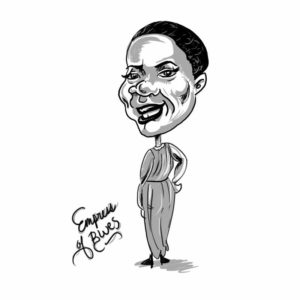
When the Great Depression hit, Smith’s singing went out of style, and alcoholism made her unreliable, which hurt her career. Her last recording, marketed towards the growing jazz audience in Europe, was made in 1933 and featured Jack Teagarden and Benny Goodman. She was again performing regularly in 1936 but died in 1937 from injuries sustained in a car accident.
Bessie Smith had a low voice and relatively narrow range but sang with attitude, feeling, soul, and bluesy inflections. She had clear intonation and could sing with a variety of expressions. Later singers like Janis Joplin and Aretha Franklin would emulate her vocal styles, and in the late 20th century, the Grammy Hall of Fame, Rock and Roll Hall of Fame, and the Library of Congress National Recording Preservation Board recognized her music and legacy.
Ex. 9.3: Bessie Smith, “Lost Your Head Blues”
The piano provides accompaniment that supports the main melodies: the alternating trumpet and vocal parts. You can hear Bessie Smith’s dynamic range in this piece, going from powerful and harsh to tender and beautiful; she adds lots of expressive variations from stanza to stanza.
Learn more about Bessie Smith from the Rock and Roll Hall of Fame:
Rock and Roll Hall of Fame Inductee Bessie Smith
Ragtime: A Precursor of Jazz
The term “Ragtime” is based on the idea of a “ragged time,” or “to rag,” by heavily syncopating the music. It originated in the 1890s and was played by Black musicians in brothels and saloons; during that period of a segregated United States, Black musicians generally couldn’t find employment in more respectable venues. These rags were published and sold many copies, being played for enjoyment in middle-class homes. Scott Joplin was the “King of Ragtime,” and his “Maple Leaf Rag” sold over a million copies.
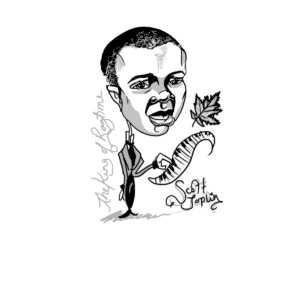
Scott Joplin was born in Texas in either 1867 or ‘68 (many people of this time didn’t know their exact date of birth). His father was an ex-slave; he played violin around the house, but he was also absent for long periods of time. Joplin’s mother provided for the family by cleaning homes. She took Scott with her, and when the house had a piano, he would plunk out tunes from church. He began studying with a local German piano instructor who introduced him to European classical music.
Joplin realized he could help the family by playing piano at brothels and dance halls and performed in Sedalia and St. Louis, MO; he also traveled to Chicago to play during the 1893 World’s Fair. While playing in Sedalia, he met music publisher John Stark, who offered him a music royalty to compose. Joplin composed ragtime music, or rags. His music uses syncopation, which refers to the act of shifting the normal accent, usually by stressing the normally unaccented weak beats or placing the accent between the beats themselves. They sounded “ragged” or jerky. Joplin was familiar with the blues, and he combined that sense of syncopation with a European sense of form and harmony, structuring them similarly to military marches. He composed a rag a week and made a living from royalties, teaching, and performing.
Joplin composed until the end of his life, but his mental health deteriorated due to syphilis. He could no longer keep up his piano technique and his memory suffered; he died at age 49 in a state mental institution. Decades after his death, his “Maple Leaf Rag” was still well known, but it was the 1973 film The Sting, which included several Joplin rags, that renewed popularity and acclaim for Joplin’s music. While he certainly saw success during his own lifetime, he said about his music, “When I’m dead 25 years, people are going to begin to recognize me.”
Ex. 9.4: Scott Joplin, The Entertainer
The Entertainer is one of Scott Joplin’s most popular compositions and a key example of ragtime.
New Orleans Jazz
Jazz has roots in ragtime, but it came into its own genre in New Orleans. Jazz fuses the intricate rhythms, improvisation, and bending vocals of African-American music with consistent phrases and rich harmonies of European music. Many of the first jazz greats played in New Orleans, a city rich with so many different cultures, and where music was constantly performed: you could hear opera, marches, ballroom dances, blues, ragtime, and Cuban dance music, along with live music at parades and in bars and brothels. The musicians performed without music, often altering and improvising off of the melody and feeling when the chords changed.
Louis Armstrong (1901-1971)
Louis Armstrong, one of the most important figures in jazz, is still remembered decades after his death for songs like “Hello Dolly” and “What a Wonderful World.” Time magazine includes him among the most influential Americans of all time. But he came from humble beginnings.
Armstrong grew up in New Orleans and started working at a young age to help support his family, dropping out of school in fifth grade. His father deserted the family shortly after Louis’ birth, and his mother often had to resort to prostitution. His first music instruction came at the Colored Waif’s Home for Boys, where he was sentenced for firing a gun on New Year’s Eve as an 11-year-old. As he got older, he moved across the country, playing with the premier bands of New Orleans, Chicago, and New York City. He appeared on dozens of albums, including backing up Bessie Smith. He moved back to Chicago and recorded a huge number of albums with his own bands, Louis Armstrong and His Hot Five and Hot Seven. These records are some of the most important in early jazz history; they were improvised, with New Orleans musicians playing New Orleans-style music.
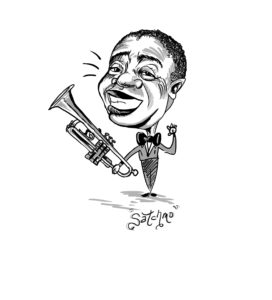
Armstrong continued to record and perform. In the 1950s and ‘60s, he played all over the world, serving as an international ambassador of swing. In the last years of his life, he knocked the Beatles off the top of the pop charts with “Hello Dolly” (no jazz recording since has ever topped the charts) and recorded “What a Wonderful World,” a song inspired by his home in Queens. He said, “The memory of things gone is important to a jazz musician. Things like old folks singing in the moonlight in the backyard on a hot night or something said long ago.”
He played with a hot, flashy style and sang with a sound completely his own. He was nicknamed “Satchmo,” an abbreviation of Satchelmouth, for his large mouth.
Ex. 9.5: Louis Armstrong and His Hot Five, “Gut Bucket Blues”
Everyone jumps in around the main melody at the beginning and end of the piece. Individual instrumentalists each have a chance to shine as they play short solos in the middle piece. This format, with a larger group playing at the beginning and end of pieces, with soloists taking turns improvising in the middle, became a staple of jazz playing.
Learn more about Louis Armstrong from the Rock and Roll Hall of Fame:
Rock and Roll Hall of Fame Inductee Louis Armstrong
Big Bands and Swing
Armstrong’s recordings sold extremely well, and the 1920s became the “Jazz Age.” A genre born in brothels was now being played in ballrooms and large dance halls, where hundreds would gather to dance. A larger venue required a larger band, leading to the popular big bands of Duke Ellington, Benny Goodman, Count Basie, and Glenn Miller in the 1930s and 1940s. Showing both the coordination required of a larger group and the desire for a more polished, even classy, sound, the arrangements were orchestrated ahead of time and read by performers. This style isn’t as “hot” as early jazz. Rather, it “swings.”
Bonus Video: Benny Goodman “Sing, Sing, Sing”
YouTube Video: “Benny Goodman Orchestra “Sing, Sing, Sing” Gene Krupa – Drums, from ‘Hollywood Hotel’ film (1937)” by dennman1
Bonus Video: Duke Ellington “Take the A Train”
YouTube Video: “Duke Ellington, ‘Take the A Train'” by morrisoncoursevids
Bonus Video: Count Basie “Swingin’ the Blues”
YouTube Video: “COUNT BASIE Swingin’ the Blues, 1941 HOT big band swing jazz” by that1940sguy
George Gershwin (1898-1937)
Gershwin was born to Jewish immigrants at the turn of the twentieth century, and as a child, he learned popular tunes by ear and formally studied European classical music. He quit school at age 15 to work in Tin Pan Alley.
Gershwin was a brilliant talent who dropped out of school at the age of fifteen to begin a professional career playing piano in New York’s “Tin Pan Alley.” The American music industry is rooted in Tin Pan Alley, a section of New York where publishers notated, printed, and sold sheet music of popular songs. It got its name as all of the pianists playing different songs sounded like a jumble of tin cans being banged. George Gershwin’s first job was working as a song plugger in Tin Pan Alley, singing and playing samples of sheet music to prospective customers. He became wealthy and well-known at age 21 with his song “Swanee.” He proceeded to write both Broadway shows and works for orchestra. He integrated jazz and classical elements to create symphonic jazz.
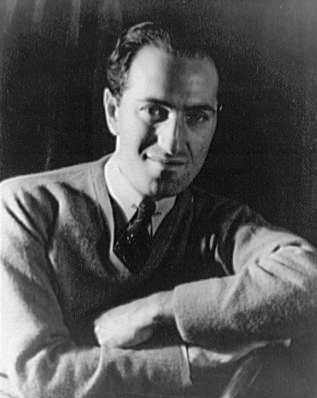
Ex. 9.6: George Gershwin, Rhapsody in Blue
After several years of success as a performer and composer, Gershwin was asked by the famous bandleader Paul Whiteman to compose a work that would help raise people’s perceptions of jazz as an art form. The resulting work, Rhapsody in Blue, combines the American blues style with the European symphonic tradition into a brilliant composition for piano and orchestra. Listen to how beautifully Gershwin combines these elements in the video below.
In addition to Rhapsody in Blue, George Gershwin is also known for his opera, “Porgy and Bess.” Although not a true opera in the strict sense of the term (Gershwin dubbed it a “folk opera”), the piece is considered one of the great American operatic works of the century. The story is set in a tenement in Charleston, South Carolina. Based on DuBose Heyward’s novel Porgy, the opera incorporated classically trained Black singers to depict the tragic love story between the two main title characters. Gershwin based the music for the opera on elements of folk music, referring to southern Black musical styles such as the blues and spirituals. Drawing on the nineteenth-century opera tradition, Gershwin made use of leitmotifs to represent people or places. Near the beginning of the opera, we hear the famous aria “Summertime,” which depicts the hot, hazy atmosphere in which the story is set.
Bonus Video: George Gershwin – “Summertime”
Porgy and Bess presents a story of African-American life in South Carolina. The song “Summertime” serves as a musical idée, a recurring melody throughout the opera. The singer has the freedom to “jazz” the piece up with inflections, sliding between pitches, and playing with the rhythm.
YouTube Video: “Porgy & Bess ‘Summertime'” by amadeusvideolog
Bebop
The swing era ended around 1945, the end of World War II. In the jazz world, young and talented performers had become less interested in sticking to a written chart, or written arrangement, and would meet in late-night clubs with like-minded musicians, improvising on tunes. This music became bebop, or bop: fast, driving music played by a small group (five instrumentalists or so) with incredible skills. While swing was meant for dancing, bebop was meant for listening.
Charlie “Bird” Parker (1920-1955)
The music and influence of Charlie Parker can be summed up in his own words: “There is no boundary line to art.” Charlie Parker is one of the primary founders of modern jazz, including bebop.
He explored the boundaries of melody, rhythm, and harmony on his saxophone and in his compositions. His motto could be said to be learn, practice, and forget. He said, “You’ve got to learn your instrument. Then you practice, practice, practice. And then when you finally get up there on the bandstand, forget all that and just wail.” It was during those times of forgetting up on stage that the music of Charlie Parker was born.
Parker didn’t start playing the saxophone until age 11. He was born and raised in Kansas City, so he was influenced by the music of Count Basie and Bennie Moten at an early age. Parker started performing with various groups while holding several other jobs. One of his jobs was as a busboy making $9 per week at a restaurant where he heard the music of Art Tatum. Later he would play with Earl Hines, collaborate with Dizzy Gillespie and Thelonious Monk, and learn from Maury Deutsch.
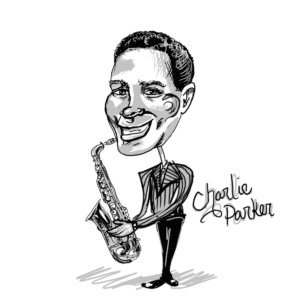
Parker brought an intellectual element to his jazz. Many of his contemporaries of the time saw the traditional Big Band music as too cautious and restrictive. They didn’t feel it reflected the experience of urban society. Bebop was born out of the search for music that reflected that aspect of life, and according to Parker, “If you don’t live it, it won’t come out of your horn.” His music spoke to the difficulties and frustrations of urban life during those times. This music features asymmetrical rhythms, long complex melody lines, and new chords. Unfortunately, his lack of boundaries also included portions of his personal life, and drug and alcohol abuse cut short his life at age 34.
Parker and trumpet player Dizzy Gillespie were virtuosic improvisers; they took standards (previously popular songs) and used them as a framework for spontaneously creating melodically and harmonically complex melodies.
Bonus Video: Charlie Parker – “My Melancholy Baby”
“My Melancholy Baby” was originally written in Tin Pan Alley in 1912. The melody is presented in a straightforward presentation at the beginning, and the soloists each take a turn complexly reworking the melody or creating new melodies around the chord changes.
YouTube Video: “My Melancholy Baby” by Charlie Parker
Clora Bryant, Trumpter (1927-2019)
Clora called herself a “trumpetiste”—she was among the first Los Angeles bebop musicians, played in all-women bands during and after World War II, and was a prominent musician in the International Sweethearts of Rhythm. Dizzy Gillespie served as one of her mentors; she then mentored many musicians and was an elder statesperson in the jazz scene in Los Angeles, California.
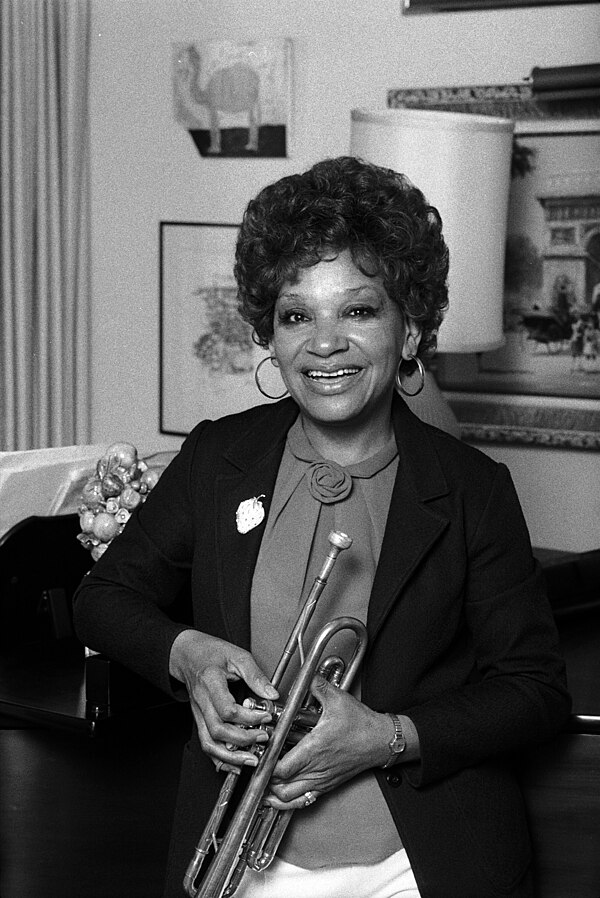
Bonus Video: Clora Bryant
YouTube Video: “Clora Bryant (Trumpetiste) – Interview – Ladies Behind the Beat.TV” by behindthebeattv
Bonus Video: Clora Bryant, “Tea for Two”
YouTube Video: “Tea for Two” by Clora Bryant – Topic
Other Jazzes: Cool and Modal
By the middle of the twentieth century, jazz had developed distinct styles: New Orleans-style, swing, and bebop. Cool jazz emerged as a reaction to bebop, with a softer sound and relaxed solos. It began with Miles Davis’ album Birth of the Cool in 1949. One of the musicians with Davis, John Coltrane, started modal jazz, which used modal melodies and less frequent chord changes.
Miles Davis
Miles Davis is one of the most important jazz musicians with his work as a trumpet player, bandleader, and composer. After the early bebop records of the 1940s, Miles Davis either led or contributed to a variety of developments with jazz. During his early career, he accompanied bebop musicians like Charlie Parker. His collaborations with arrangers and composers produced two immensely influential and successful albums: The Birth of the Cool in 1949 and Kind of Blue in 1959.
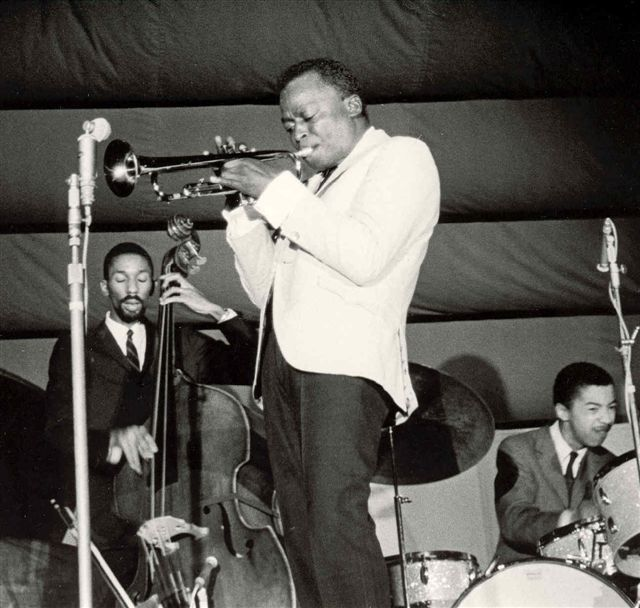
With Kind of Blue, Davis worked in the subgenre of “modal jazz,” where musicians improvised for longer times with a single scale rather than the rapidly moving chords and key centers of earlier jazz. He was a pioneer in jazz fusion with his album 1970 Bitches Brew, and several of his bandmates like Tony Williams, Wayne Shorter, Herbie Hancock, and John McLaughlin would have successful jazz-fusion careers in their own right.
Bonus Video: Miles Davis, “So What”
YouTube Video: “Miles Davis – So What (Official Video)” by Miles Davis
Learn more about Miles Davis from the Rock and Roll Hall of Fame:
Rock and Roll Hall of Fame Inductee Miles Davis
John Coltrane
John Coltrane, the son of a minister, became one of the most influential saxophone players in jazz history. He played on particularly important albums of Thelonious Monk and Miles Davis. Coltrane was very spiritual and was practically always playing or practicing music.
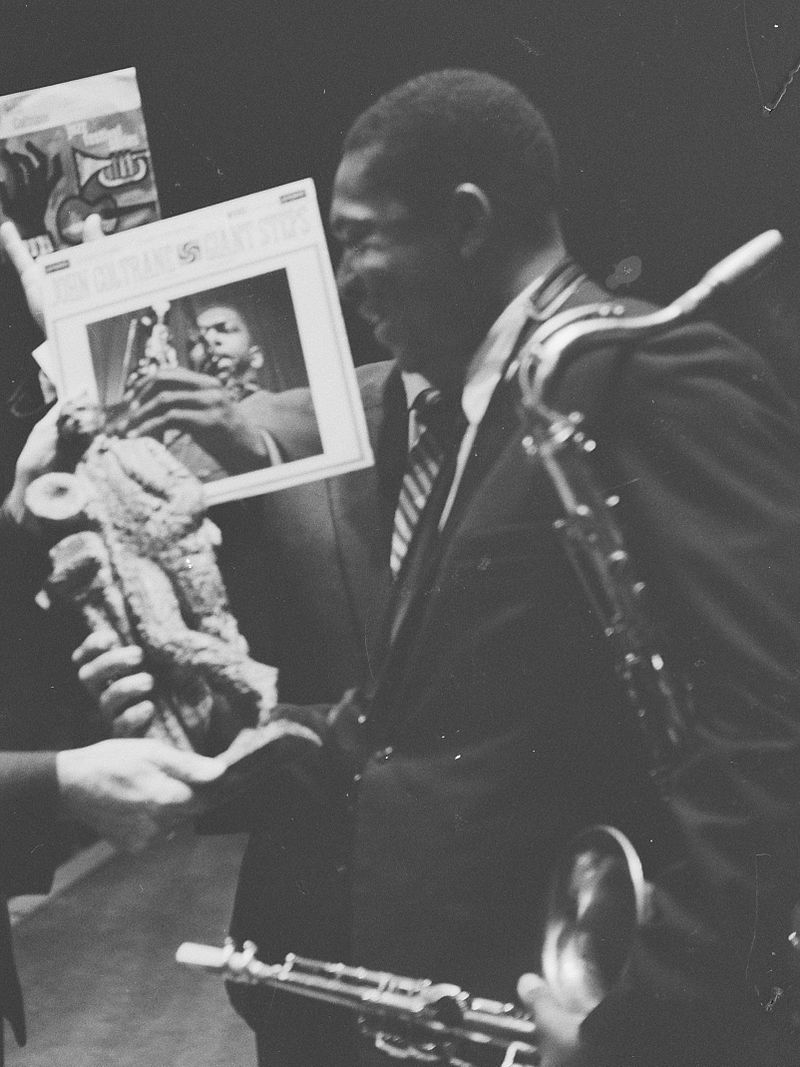
Coltrane’s most important musical contribution is his four-movement album A Love Supreme. Coltrane recorded it after a “religious awakening.” The last movement, “Psalm,” includes a “musical narration” of a text (included with the liner notes) that he wrote himself, “playing” the words of the poem into his saxophone.
Bonus Video: John Coltrane: “Psalm”
This video outlines how Coltrane’s sax melody aligns with the text he wrote. As part of Coltrane’s lasting legacy, the Church of St. Coltrane in San Francisco has weekly performances of the music from A Love Supreme.
YouTube Video: “John Coltrane’s “Psalm” Animated [A LOVE SUPREME]” by RamseyCastaneda
Bonus Video: John Coltrane: “My Favorite Things”
Coltrane, on his breakthrough modal jazz album My Favorite Things of 1960, improvised on Broadway tunes that were immensely popular with the American public. He took relatively simple songs and improvised for long stretches of time over just two chords, weaving together melodically abstract sounds. It’s worth noting that Coltrane was influenced by Ravi Shankar and Indian music (which we listened to in Chapter8); Coltrane’s improvisations are similar in ever-churning melodies over the same chords.
YouTube Video: “John Coltrane “My Favorite Things” 1961 (Reelin’ In The Years Archives)” by ReelinInTheYears66
Jazz-Fusion and Beyond
Jazz continued to branch out into new styles. Jazz-fusion of the 1970s blended rock and jazz, incorporating electric bass and strong backbeat drumming; Smooth jazz emerged in the 1980s with the mellow sounds of Kenny G. These different offshoots of jazz generally lean towards the hot or the cool.
For two examples, listen to the rock-jazz-Eastern hybrid Mahavishnu orchestra and the more pop/funk-influenced Weather Report.
Bonus Video: Mahaivshu Orchestra, Birds of Fire
YouTube Video: “Birds of Fire – Mahavishnu Orchestra” by GilmoursAngst
Bonus Video: Weather Report, Birdland
YouTube Video: “Birdland” by Jazzman 2696
Rock Music
While rock music is a relatively young genre compared to other music we’ve studied, there are numerous artists working in widely varied styles. We’ll examine the roots of rock music, along with a sample of subgenres.
Antecedents of Rock
We saw how swing music was especially popular in the 1930s and 1940s. After World War II, some audiences moved on to bebop and other jazz subgenres, while others listened to rhythm and blues—R&B. Both bebop and R&B had a rhythm section with piano, guitar, bass, and drums accompanying horns, but R&B (first known as “race music” or “Jump blues”) was song and dance music. Vocalists sang about love in a clear 4/4 meter, with drums accenting the weaker beats. It was first popular among Black audiences but soon swept the United States.
Rock and Roll
Radio disk jockey Alan Freed called this new R&B music “rock and roll” as white audiences began embracing it. His broadcasts were also heard in Europe, spreading rock and roll’s popularity.
Bonus Video: Ike Turner’s Kings of Rhythm, “Rocket 88”
Many consider this the first rock and roll song.
YouTube Video: “Rocket 88 (Original Version) – Ike Turner/Jackie Brenston” by HuckToohey
Elvis Presley
Elvis Presley was the first megastar of rock and roll, “The King of Rock and Roll.” Born in Tupelo, Mississippi, he grew up playing “hillbilly music” and singing in church while listening to blues and jazz in Black Memphis, Tennessee neighborhoods. He combined various stylistic elements of white and Black music, and his first record featured a bluegrass cover on one side and a Black Mississippi Delta blues song on the other. His recording career began in
Memphis in 1954 when he worked with Sam Phillips, the owner of Sun Records. Elvis soon moved to the RCA label, and his first single record “Heartbreak Hotel,” released in 1956, became the number-one hit in the United States. By embracing music from both sides of the civil rights movement, Elvis became both very popular and very controversial at the same time. In many ways, he helped bring the popular music of Black people into the mainstream of white society and paved the way for groups like the Beatles and the Rolling Stones, who were heavily influenced by Black artists.
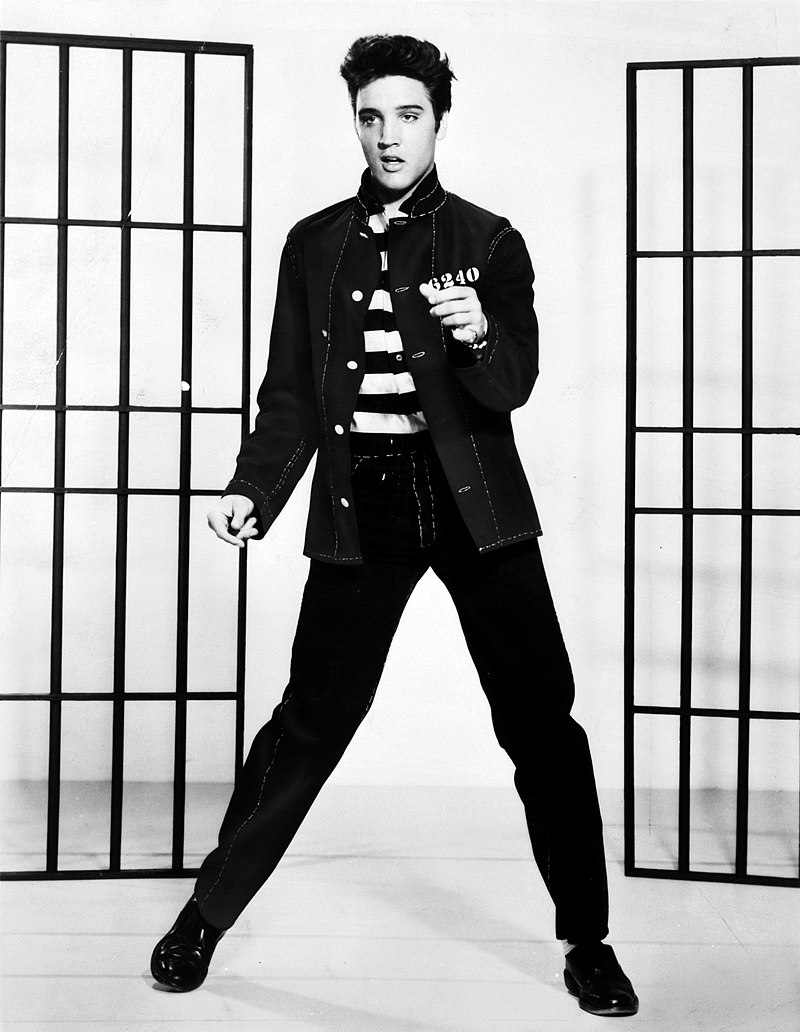
Bonus Video: Elvis Presley, “Hound Dog”
At a time when television was still a new medium, Elvis’s television performances, like those in the video below, put rock and roll in households throughout America. “Hound Dog” was originally recorded by Big Mama Thornton. Her recording was a number-one hit that sold a half-million copies, and Elvis’s copy sold ten million copies and became one of the best-selling singles of all time. To consider: what factors made Elvis’s version a bigger hit?
Elvis was exceedingly popular as a recording artist and on television and film; he had 149 songs on the Billboard charts and appeared in over thirty films. Elvis later branched out and recorded many successful ballads and rock tunes. He died of a drug overdose in 1977.
YouTube Video: “Elvis Presley – Hound Dog (1956) HD 0815007” by ForbiddenInGermany4
Learn more about Elvis Presley from the Rock and Roll Hall of Fame:
Rock and Roll Hall of Fame Inductee Elvis Presley
Rock Matures: The Beatles and Jimi Hendrix
While Elvis helped catapult the popularity of the rock genre, the Beatles showed its artistic potential and became one of the most famous rock groups of all time. Influenced by American rock and roll and R&B, they originally played covers and appealed to teens. Producer George Martin influenced them to stretch their horizons both in songwriting and studio recording techniques. Principal songwriters Paul McCartney and John Lennon moved from songs about typical boy-girl relationships to lyrics that were more poetic and unique with original sounds.

This British group toured the United States in 1964 and changed the face of popular music and the recording industry from that time forward. The Beatles popularized the use of electric guitars as the basis of the modern rock band and went on to add strings, brass, organ, and more to the list of instruments used in rock performances and recordings. Their use of straight eighth notes on the cymbals and accents on beats two and four on the snare drum are classic rock and roll rhythm elements.
In 1966 they stopped performing live and focused on creating in the music studio. With Sgt. Pepper’s Lonely Hearts Club Band in 1967, they created the first concept album, a collection of songs with unified music and lyrics instead of a collection of potential hits. As the genre matured, “rock and roll” became known simply as “rock.” The Beatles, along with The Rolling Stones, Cream, and Led Zeppelin brought a British Invasion of rock music.
Bonus Video: The Beatles, “Yesterday”
In Chapter 1, we listened to “Yesterday,” one of the most critically acclaimed and financially successful recordings of popular music. The song looks back at an ended relationship.
YouTube Video: “Yesterday (Remastered 2009)” by The Beatles
Learn more about the Beatles from the Rock and Roll Hall of Fame:
Rock and Roll Hall of Fame Inductee The Beatles
Jimi Hendrix, a guitarist, singer, and songwriter, further expanded what was musically possible in rock music. He could incorporate simpler blues and more complex jazz melodies and harmonies into his playing and even used noise from the electric guitar and amplifier (a typically unwanted byproduct) as part of the music.
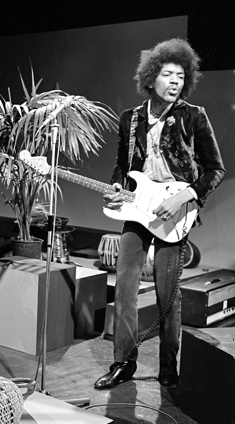
Bonus Video: Jimi Hendrix, “The Star Spangled Banner”
Hendrix’s performance of “The Star-Spangled Banner” at Woodstock in 1969 is especially iconic. Between the powerful treatment of the melody on the electric guitar, he interjects noise that reflects the carnage of war (a musical protest of the Vietnam War) and a brief moment of “Taps,” typically performed by solo trumpet to honor former military personnel who have died.
YouTube Video: “Jimi Hendrix – The Star Spangled Banner [ National Anthem ] ( Live at Woodstock 1969 )” by Looky Lambert
Learn more about Jimi Hendrix from the Rock and Roll Hall of Fame:
Rock and Roll Hall of Fame Inductee Jimi Hendrix
Soul, Motown, and Funk
As rock became more established, more subgenres emerged. Berry Gordy founded Motown in Detroit, an outfit that crafted a very polished product, both musically and visually, churning out legends like Diana Ross and the Supremes, The Temptations, Stevie Wonder, and The Jackson 5.
Motown had a broad appeal among Black and white audiences, while soul, a genre with more rhythmic complexity and room for improvisation that grew into funk, was popular with predominantly Black audiences. Ray Charles and James Brown epitomized soul music.
Bonus Video: Ray Charles, “I Got a Woman”
YouTube Video: “I Got A Woman” by Ray Charles
Learn more about Ray Charles from the Rock and Roll Hall of Fame:
Rock and Roll Hall of Fame Inductee Ray Charles
Bonus Video: James Brown, “I Feel Good”
James Brown, in addition to creating the genre of funk, greatly influenced future King of Pop Michael Jackson.
YouTube Video: “I Got You (1964 Smash Version)” by James Brown
Learn more about James Brown from the Rock and Roll Hall of Fame:
Rock and Roll Hall of Fame Inductee James Brown
The Supremes
The Supremes, an all-women singing group, became Motown’s most successful act. Original members included Florence Ballard, Mary Wilson, Diana Ross, and Betty McGlown; they came from the Brewster-Douglass public housing project in Detroit. They were originally called the Primettes and were connected with the Primes (a group that would become Motown’s Temptations). Diana Ross was the lead singer; they even rivaled the popularity of the Beatles during the height of Beatlemania. “Where Did Our Love Go?” became their first big hit and the first of a string of five consecutive Number One hits. Diana Ross would eventually leave to pursue a successful solo career as a singer and actress and would later be a mentor to future Motown musician Michael Jackson when he was a child.
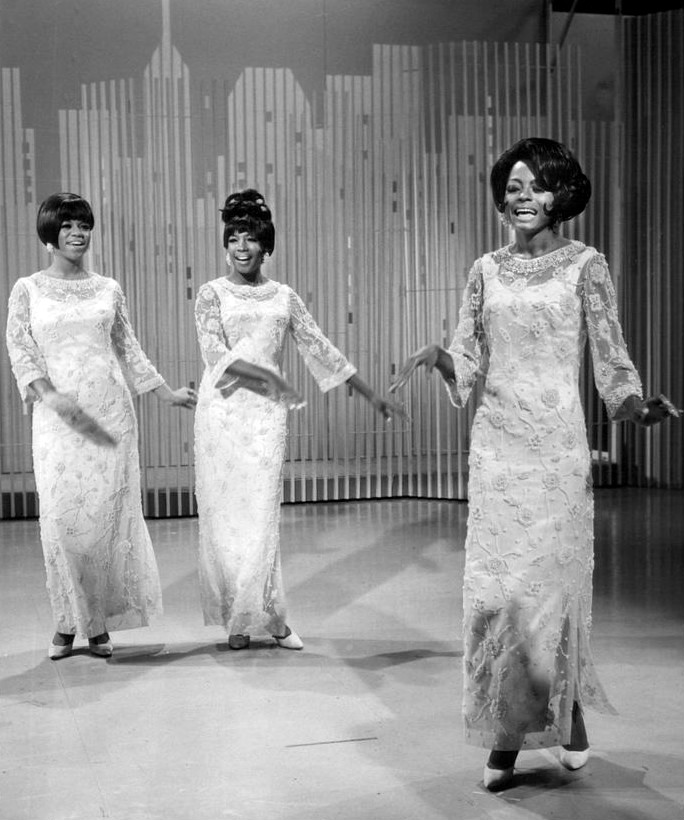
Bonus Video: The Supremes – “Where Did Our Love Go?”
The Supremes pursued a glamorous look and sound; Ross sang with a subdued style, which was described as “greatly envied for the torchy, come-hither purr in her voice.” The group performed graceful choreography with fancy gowns, wigs, and makeup.
YouTube Video: “Where Did Our Love Go” by Release – Topic
Learn more about the Supremes from the Rock and Roll Hall of Fame:
Rock and Roll Hall of Fame Inductee The Supremes
Michael Jackson
Michael Jackson went from being the pint-sized frontman of The Jackson 5 to the King of Pop. His 1982 album Thriller demonstrated his mastery of several rock subgenres and is the best-selling album of all time. Collaborated with legendary producer Quincy Jones, it was designed to have as much crossover appeal as possible during a time when music was still predominantly intended for Black or white audiences, young or old audiences, etc. The music video for the title track is generally considered to be among the greatest music videos ever.
Bonus Video: Michael Jackson, “Thriller”
YouTube Video: “Michael Jackson – Thriller (Official 4K Video)” by Michael Jackson
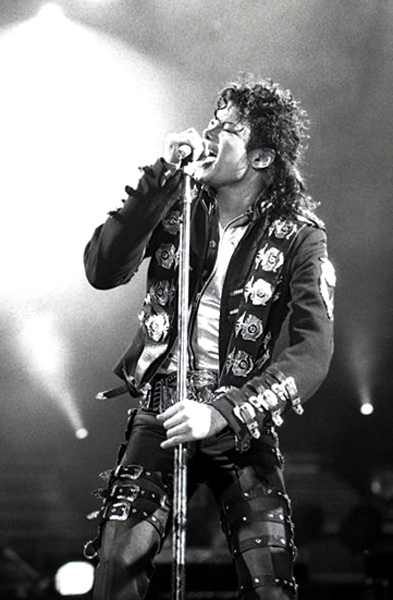
While Michael Jackson became almost incomprehensibly famous, he also achieved a level of notoriety. Some of this was unfair: his skin famously turned from dark to light and he was accused of doing that intentionally, when he actually had a skin condition called vitiligo, a disease that causes skin to lose color. Some of his notoriety also came from repeated allegations of sexually abusing children.
The following article provides insight into one listener’s experience on how to respond to Michael Jackson’s music—which is excellent—amidst the continued allegations against him—which are disturbing.
Article: Before and After – What it’s like listening to Michael Jackson now
Learn more about Michael Jackson from the Rock and Roll Hall of Fame:
Rock and Roll Hall of Fame Inductee Michael Jackson
Madonna
Madonna (Madonna Louise Ciccone)—the “Queen of Pop”—is a singer, songwriter, and actress from the United States. In 1978, she moved to New York to pursue modern dance. She was a drummer, guitarist, and vocalist in rock bands before her debut solo and self-titled album in 1983. She rose to superstardom in the 1980s and continued to be a pop culture phenomenon into the 1990s and 2000s. Through the decades, she repeatedly reinvented her image and music. She has been both celebrated and criticized for the social, sexual, and religious lyrics and imagery in her songs and music videos.
Madonna is the most successful solo artist in U.S. Billboard Hot 100 chart history and has sold more albums—300 million— than any other female musician. MTV and Billboard ranked her the world’s greatest music video artist.

Bonus Video: Madonna, “Material Girl”
YouTube Video: “Madonna – Material Girl (Official Video) [HD]” by Madonna
Madonna’s career coincided with the peak of music video’s popularity on MTV. This video paid homage to Marilyn Monroe and her performance in the 1953 classic Gentlemen Prefer Blondes with its choreography and costumes. It was made around the same time as Madonna’s music videos became something like short films; the music video isn’t simply dancing to the song; there’s spoken dialogue and a loose plot that bookends and is interspersed between the song segments. In addition to being a classic Madonna song, the message that “We are living in a material world” also fits perfectly into the 1980s, sometimes called the Decade of Materialism. Making money and buying new things was especially prominent in the ‘80s culture.
Learn more about Madonna from the Rock and Roll Hall of Fame:
Rock and Roll Hall of Fame Inductee Madonna
Punk Rock and New Wave
Punk rock—fast, hard, and simple—arrived in the 1970s and became something of a backlash against the super-polished sounds of disco. Lyrics reflected everyday life. Punk rockers like the Ramones, the Sex Pistols, and The Clash would inspire new wave musicians (similar to punk, but more experimental) like Elvis Costello and the Attractions, the Police, and the Talking Heads.

Bonus Video: The Ramones, “Blitzkrieg Bop”
YouTube Video: “Blitzkrieg Bop (2016 Remaster)” by The Ramones
Learn more about the Ramones from the Rock and Roll Hall of Fame:
Rock and Roll Hall of Fame Inductee The Ramones
Metal
Metal is generally built around power chords—two-note chords with a root and a fifth—a sound used by the power trios of the 1960s. As the genre developed, lyrics were often related to dark, surreal, angry, or powerful subject matters. Metallica is a defining example of metal, particularly their songs from the mid-to-late 1980s.
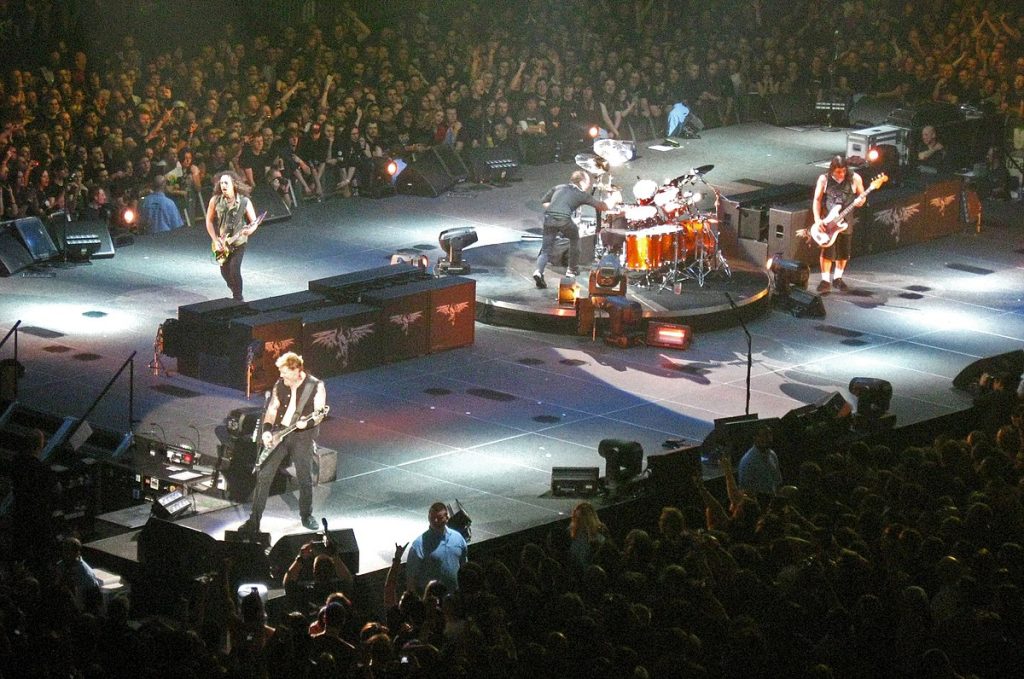
Bonus Video: Metallica, “Master of Puppets.”
This hard-hitting and complex song—with various parts and a duration of over 8 minutes—tackled the subject of addiction.
YouTube Video: “Metallica-Master Of Puppets (Lyrics)” by MotherRussiaMr
Learn more about Metallica from the Rock and Roll Hall of Fame:
Rock and Roll Hall of Fame Inductees Metallica
Tracing Metal’s Roots to the Blues
Metallica has profoundly influenced popular music and brought heavy metal to the mainstream. They influenced plenty of musicians. But it’s worth tracing their own influences.
Metallica’s vocalist and rhythm guitarist James Hetfield grew up idolizing Aerosmith. Hetfield wasn’t sure if he wanted to be a vocalist like Steven Tyler or a guitarist like Joe Perry, so he decided to do both, capturing this aggressive spirit you can hear in both their singing and guitar playing, respectively.
The rock band Aerosmith was started because there was a group of musicians who shared a love of 60s rock bands like The Rolling Stones, The Yardbirds, and Led Zeppelin. And these bands all shared one distinctive, common trait: a profound respect for the influence of blues guitarist and vocalist Robert Johnson.
Keith Richards of the Rolling Stones said of Robert Johnson: “You want to know how good the blues can get? Well, this is it.” Eric Clapton of The Yardbirds and Cream called him “the most important blues musician who ever lived.” Robert Plant, lead singer of Led Zeppelin, said of him: “Robert Johnson, to whom we all owed our existence, in some way.”
So what made Robert Johnson so influential? As described above, in the 1930s, he moved from town to town, playing on street corners for tips. While he’s primarily remembered for his blues playing and singing, he was a versatile performer who could quickly learn songs by ear. A talent scout got him in contact with a recording studio in Texas. These recordings weren’t popular at the time, but around 1960, they were re-released during a time when American folk music was enjoying renewed popularity. Rock and roll musicians discovered—and devoured—these recordings. His guitar playing sounded like two different guitarists, and he would also play his guitar as if it were another vocalist singing with him.
Metal in the 2020s: Unleash the Archers
Vocalist Brittney Slayes and drummer Scott Buchanan formed the metal group Unleash the Archers in 2007 when they were university students at the University of Victoria on Vancouver Island in British Columbia, Canada. Their music incorporates different styles of heavy metal and popular music. According to their website, “they embrace a commercial appeal that attracts music lovers of all types while maintaining a heavy edge that remains true to their death metal roots.”
The band is active on social media connecting with their fans throughout the world, sharing videos of hot sauce challenges and playing Dungeons and Dragons.
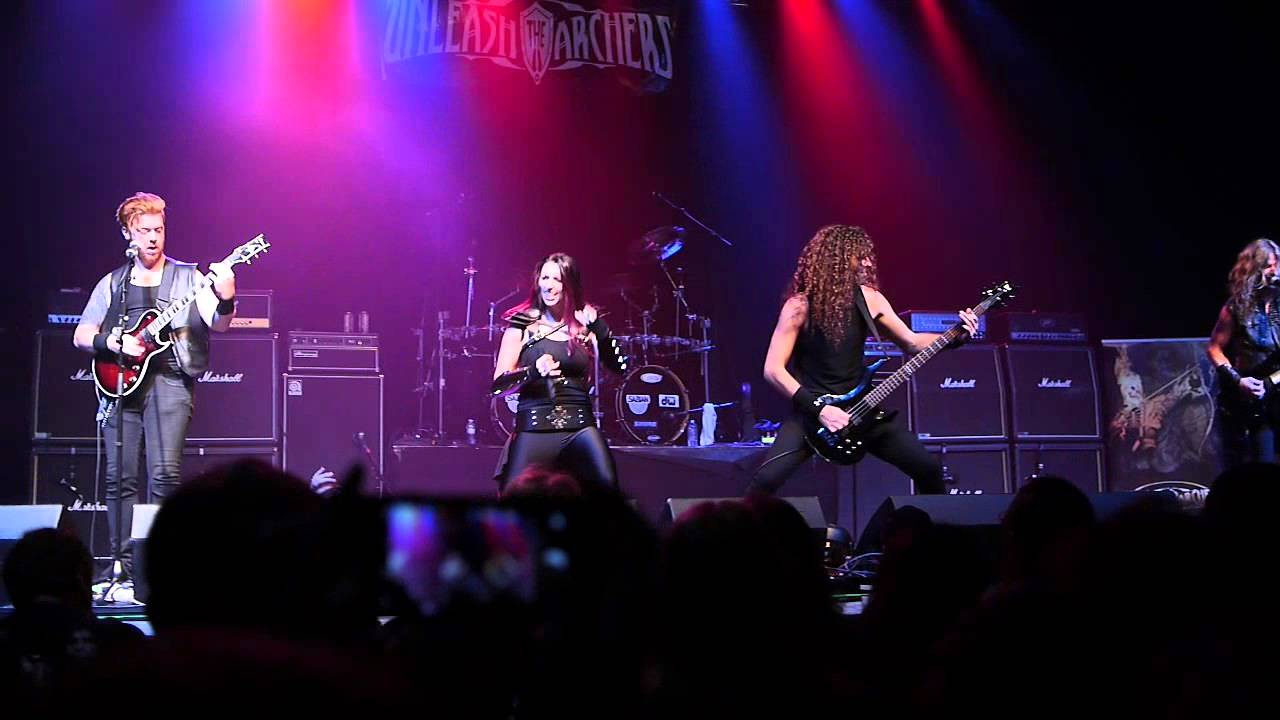
Bonus Video: Unleash the Archers, “Legacy”
One YouTube comment on this video stated, “This album is what riding a unicorn through a thunderstorm sounds like.” Metal often highlights the most virtuosic moments of a piece—a bass fill, a guitar solo, etc. While this piece has a guitar solo, the virtuosic drums and guitar create waves of sound woven into the fabric of the whole song.
YouTube Video: “UNLEASH THE ARCHERS – Legacy (Official Lyric Video) | Napalm Records” by Napalm Records
Grunge
Grunge, something of a soundtrack for Generation X, was a reaction against the excesses of earlier rock music, particularly glam rock and hair metal. Nirvana and lead singer Kurt Cobain were the most notable examples of grunge. Their songs could be angry, annoyed, or joking, and unlike much of the rock music of the previous decade, were distinct by their non-virtuosity. The lyrics could be a hodgepodge of absurdity, but they strongly resonated and came across as poetic. Their most recognized song is “Smells Like Teen Spirit.”
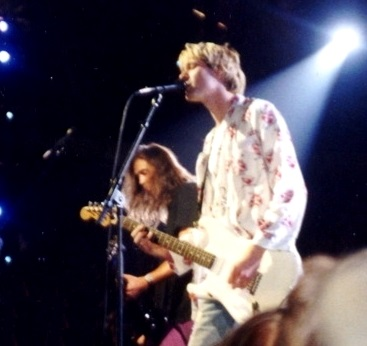
Bonus Video: Nirvana, “Smells Like Teen Spirit”
YouTube Video: “Nirvana – Smells Like Teen Spirit (Official Music Video)” by Nirvana
Learn more about Nirvana from the Rock and Roll Hall of Fame:
Rock and Roll Hall of Fame Inductee Nirvana
Rap and Run-DMC
Rap emerged in the early 1970s in New York; DJ Kool Herc isolated certain parts of James Brown songs on a turntable while calling out to the crowd (elements of which had been used in Jamaican music). The music was especially popular in Black communities. Rap trio Run-DMC were the first commercially successful rap musicians. Their cover of Aerosmith’s “Walk This Way” helped bring rap into the mainstream.
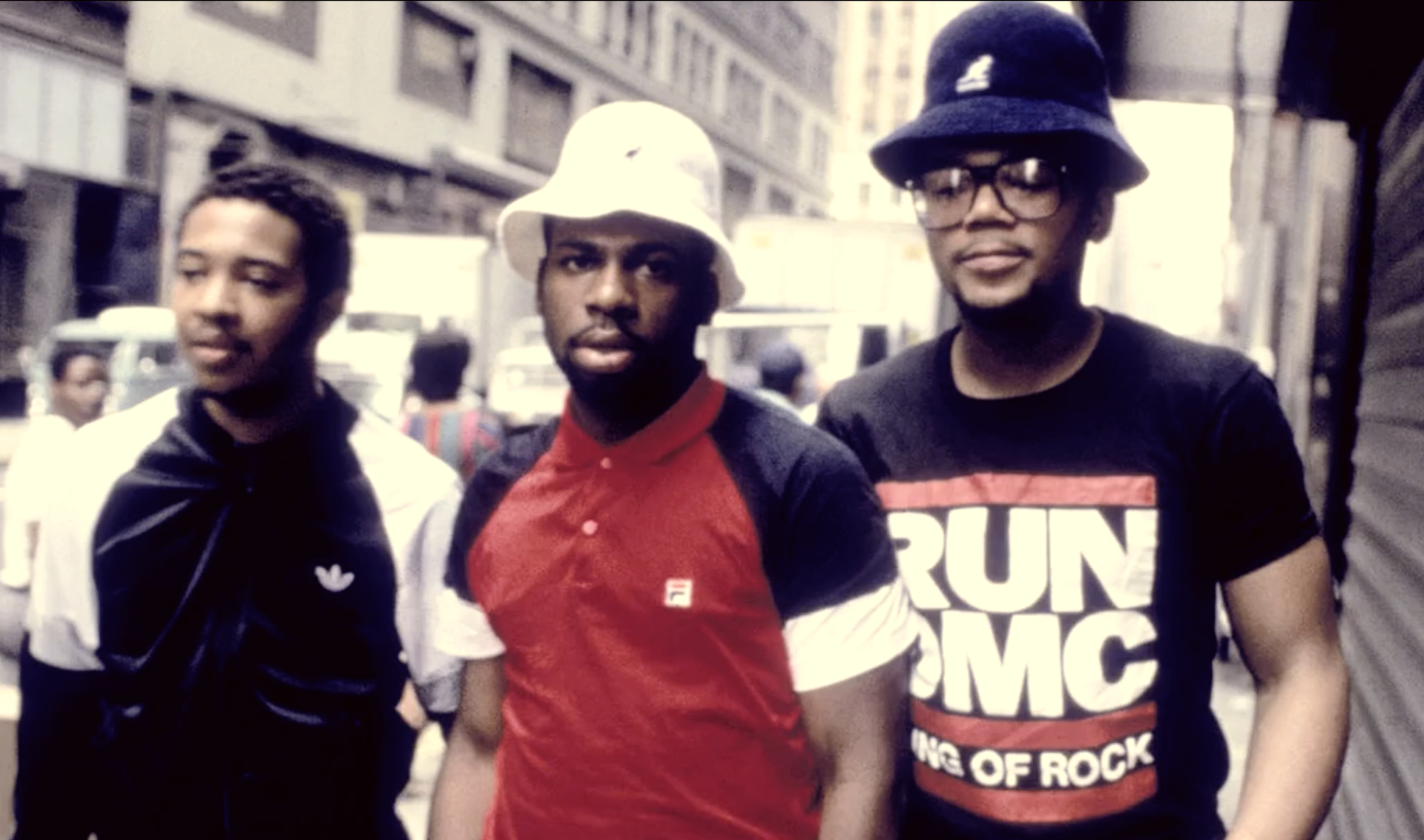
Bonus Video: Run DMC ft. Aerosmith, “Walk This Way”
YouTube Video: “RUN DMC – Walk This Way (Official HD Video) ft. Aerosmith” by Run DMC
Learn more about Run DMC from the Rock and Roll Hall of Fame:
Rock and Roll Hall of Fame Inductee Run DMC
Salt-N-Pepa: The First Ladies of Rap and Hip Hop
Salt-N-Pepa is an American rap/hip hop trio. The group was formed by three women from New York: rapper and songwriter Salt (Cheryl James), rapper Pepa (Sandra Denton), and DJ Spinderella (Deidra Roper). As the first successful all-female hip hop group, Salt-N-Pepa helped pave the way for future women rappers and hip hop artists; they had a pop-driven sound and were among the first in the rap community to achieve widespread and mainstream success. In a genre where it was common to objectify women, their songs demanded respect for women.
In 1995, Salt-N-Pepa became the first female group to win the Grammy for Best Rap Performance by a Duo or Group, the same year that Queen Latifah became the first woman to win the Grammy for Best Rap Solo Performance. Salt-N-Pepa have sold more than 15 million albums—hey are one of the most successful rap acts of all time.
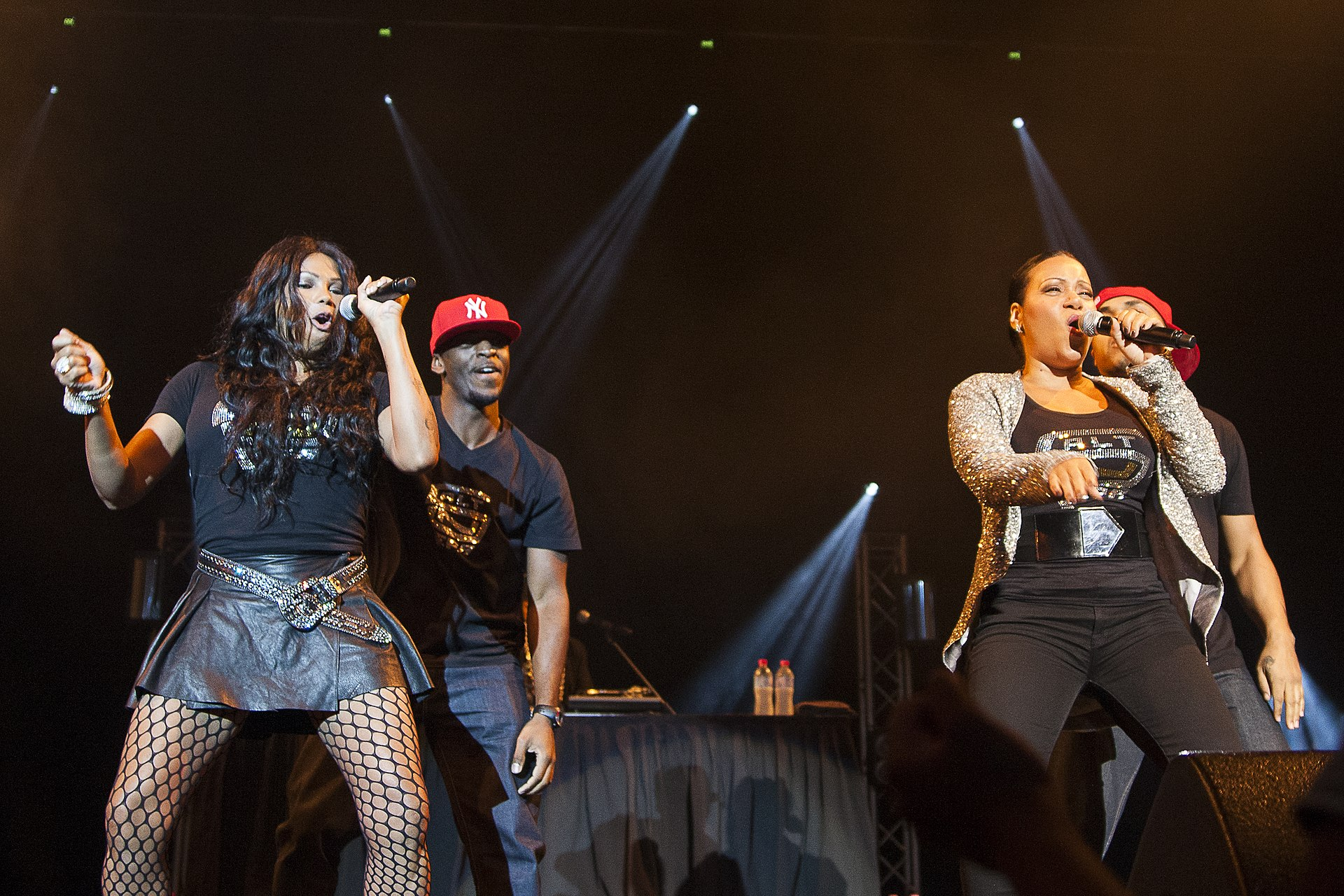
Bonus Video: Salt-N-Pepa, “Push It”
In addition to an iconic keyboard melody, Salt-N-Pepa make something new out of pre-existing material: adapting the line “Boy, you really got me goin’/You got me so I don’t know what I’m doin’.” from the Kinks “Your Really Got Me,” quotes from James Brown songs, the whispered “Push It” sampled from the band Coal Kitchen’s “Keep on Pushin.’”
YouTube Video: “Salt-N-Pepa – Push It (Official Music Video)” by Salt-N-Pepa
For a more thorough (but by no means complete) list of influential rock musicians, check out Rolling Stones’ proposed 100 greatest rock artists.
Check out this brief sample of notable Rock and Roll cities.
Interested in reading a history that ties the history of music (particularly, popular music) to intellectual property? Check out the graphic novel Theft! A History of Music:
Notable Performances in Rock and Roll History
1956 – Elvis Presley performs “Hound Dog” on The Ed Sullivan Show
Elvis’s first appearance on the Ed Sullivan drew a staggering 82.6% of all television viewers.
YouTube Video: “Elvis Presley – Hound Dog (1956) HD 0815007” by ForbiddenInGermany4
1964 – The Beatles perform “I Want To Hold Your Hand” on The Ed Sullivan Show
The performance kicked Beatlemania into high gear.
YouTube Video: “The Beatles – I Want To Hold Your Hand – Performed Live On The Ed Sullivan Show 2/9/64” by The Beatles
1965 – Bob Dylan performs at the Newport Folk Festival
Bob Dylan performed for the first time with an electric guitar. Folk music purists derided him for using the electric instrument instead of the more traditional acoustic guitar.
YouTube Video: “Bob Dylan Live at the Newport Folk Festival” by RockFM
1967 – Jimi Hendrix performs at the Monterey Pop Festival
Hendrix concluded an already epic performance with the legendary burning of his electric guitar.
YouTube Video: “Jimi Hendrix Wild Thing Guitar Sacrifice YouTube” by ashutoshjohn
1978 – Bruce Springsteen performs at Hollywood’s Roxy Theatre
Bruce Springsteen and the E Street band were becoming renowned for their 3-hour concerts of story and song, and their concert at the Roxy is especially well-regarded.
YouTube Video: “26. Born To Run (Bruce Springsteen – Live At The Roxy Theatre 7-7-1978)” by BruceBootlegs
1983 – Michael Jackson performs at Motown 25
The concert was to celebrate the 25th anniversary and impact of the legendary Motown Records, but Jackson’s performance of “Billie Jean,” and his first time dancing the “Moonwalk” stole the show and helped vault him to superstardom.
YouTube Video: “Michael Jackson – Billie Jean (Motown 25) (Remastered 4K)” by New Michael Jackson
1991 – Metallica performs at the Tushino Airfield in Moscow
This has been described as the first free show in Russia to include international rock stars, with an estimated 1-2 million people in attendance, the highest-attended concert in the acclaimed band’s history.
YouTube Video: “Metallica – Enter Sandman (Live Moscow September 28 1991 [Pro Shot])” by John Doe
1992 – The Freddie Mercury Tribute Concert
Five months after the death of Freddie Mercury, the lead singer of Queen, the surviving band members and some of the biggest names in rock gave a tribute and AIDS research benefit concert.
YouTube Video: “Queen, Elton John & Axl Rose – Bohemian Rhapsody (Freddie Mercury Tribute Concert)” by Queen Official
Music and Media
In addition to these blues-influenced genres, American popular music has been shaped by multi-media collaborations: the song-and-dance-and-drama Broadway productions, music for film, music for television, and music for video games.
The Broadway Musical
Broadway, a form of American popular musical theater, emerged in the early twentieth century with spoken dialogue and generally led up to songs as the high point of the production. Early landmark productions include Cohan’s Little Johnny Jones and its song “Give My Regards to Broadway” and Kern’s Showboat with its spiritual “Ol’ Man River.” The works of Rodgers and Hammerstein (of which we earlier heard Coltrane improvise) led to a Golden Age for Broadway.
Leonard Bernstein (1918-1900) and West Side Story (1957)
Bernstein was one of the most important figures in twentieth-century American music. To see him introduce classical music to general audiences, look up his Young People’s Concerts series. Many are available on YouTube and elsewhere online.
Bernstein, who was conductor of the New York Philharmonic, composed West Side Story as a depiction of Romeo and Juliet set in New York City; lovers Tony and Maria are connected to rival gangs in a story set with vibrant music and choreography.
The musical dramatized the tensions between white and Puerto Rican street gangs and updated the famous Shakespeare story for twentieth-century audiences. The music was also groundbreaking for its sophistication, use of modern harmonies, and incorporation of Latin music and jazz.
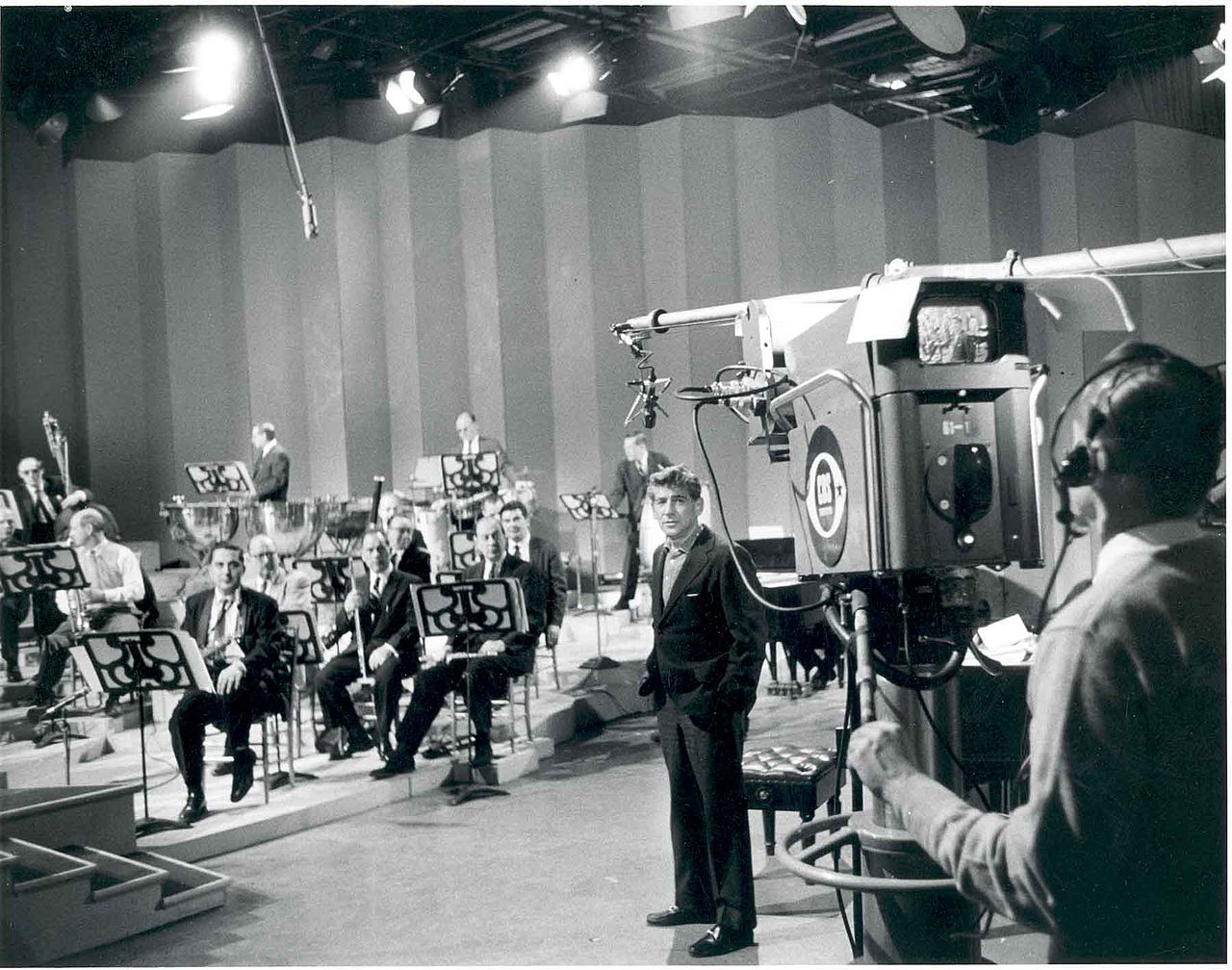
Bonus Video, Bernstein, West Side Story, “Tonight”
This song takes place on the fire escape of Maria’s apartment, evoking Juliet’s balcony in Romeo and Juliet. Tony and Maria had just met at a dance. Bernstein included Latin jazz with the choppy, syncopated brass in the background to reflect Maria’s character being Puerto Rican.
YouTube Video: “Tonight” by Release – Topic
Stephen Sondheim (1930-2021) and Sweeney Todd (1979)
Stephen Sondheim wrote the lyrics for West Side Story and became a prominent Broadway composer. He studied with both Broadway legend Oscar Hammerstein and academic Modernist Milton Babbitt, leading to a fusion of catchy songs and abstract, dissonant sounds to set his lyrics.
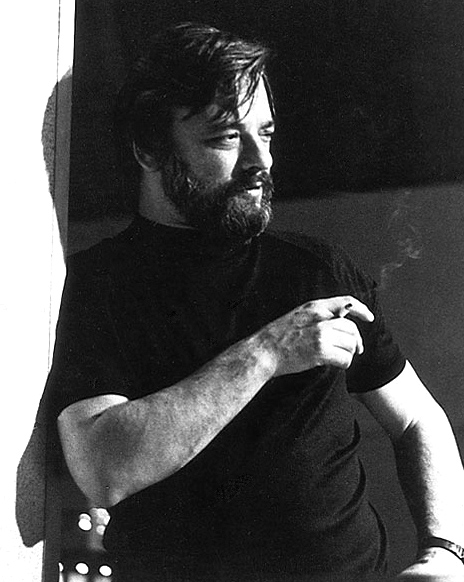
Bonus Video: Sondheim, Sweeney Todd, “The Ballad of Sweeney Todd”
The scope and drama of Sweeney Todd is almost opera-like, with its minimal spoken dialogue, technical demands on the singers, and abstract music ideas; in fact, opera companies have performed this musical. The prelude sets the grim tale of the murderous barber Sweeney Todd and Mrs. Lovett who adds his victims’ flesh to the food in her meat pie shop.
YouTube Video: “The Ballad of Sweeney Todd” by Stephen Sondheim – Topic
Andrew Lloyd Webber (1948-)
Andrew Lloyd Webber is the most successful musical-theater composer. His Phantom of the Opera premiered in 1986 and is the longest-running Broadway composer. Among the most popular songs from Phantom of the Opera are “The Music of the Night,” “Think of Me,” and “All I Ask of You.” Other Andrew Lloyd Webber megahits include “Don’t Cry for Me Argentina” (Evita), “Go, Go, Go Joseph” (Joseph and the Amazing Technicolor Dreamcoat), “Superstar” (Jesus Christ Superstar), and “Memory” (Cats).
Film, TV, and Games
The impact of sound recording technology in the twentieth century can’t be overstated; before recording, music couldn’t be heard unless it was being performed live, and now, works that called for forces as large as a hundred-plus performers, like the orchestra pieces of the Romantic period, can be instantly accessed on small, electronic devices. This has certainly altered how composers have conceived of creating sounds, especially in music for media, written not primarily for live performance, but rather to be attached to other art forms like movies, shows, and video games.
Film Music Develops
Moving pictures were first introduced in 1897 by the Lumière brothers, Auguste and Louis, in Lyon, France. They used their invention mostly as a novelty, to document life in Lyon and around the globe. But the technology soon became popular as entertainment in the United States. By the early 1910s, storefront “Nickelodeon” theaters—so named because admission cost a nickel—had sprung up in towns and cities across America. Most early films were short but were not “silent.” An improvising pianist typically provided an accompaniment, often with a percussionist rendering the sound effects.
Inspired by Classic Music: 1920s-1940s
By the 1920s, the movie industry had grown very popular, and technology allowed for filmmakers to sync movies with dialogue, sound effects, and music. Music was initially attached to space without dialogue, like credits or action sequences; these were called cues. Film composers like Max Steiner and Erich Korngold developed underscoring, music heard even during moments of dialogue. Music became more prominent in films throughout the 1930s and 1940s, with composers using different musical themes for people or places, similar to the Wagnerian leitmotif. Orchestral music was especially prominent; it worked on speakers of varying quality from theater to theater and it provided an aura of class or high art. Many of the composers were from Europe and well-versed in orchestral writing, emulating the sounds of the Romantic period that had ended a few decades earlier.
Bonus Video: Steiner, Main Titles, King Kong
Max Steiner encapsulated Golden Age Hollywood film music. His music for 1933’s King Kong was the first thematic score to be created for a major Hollywood film. This piece, which serves as an overture to the film, introduces the musical theme or leitmotif of various characters, including Kong.
YouTube Video: “King Kong: “Main Titles” by Max Steiner (Score Reduction and Analysis)” by David McCaulley
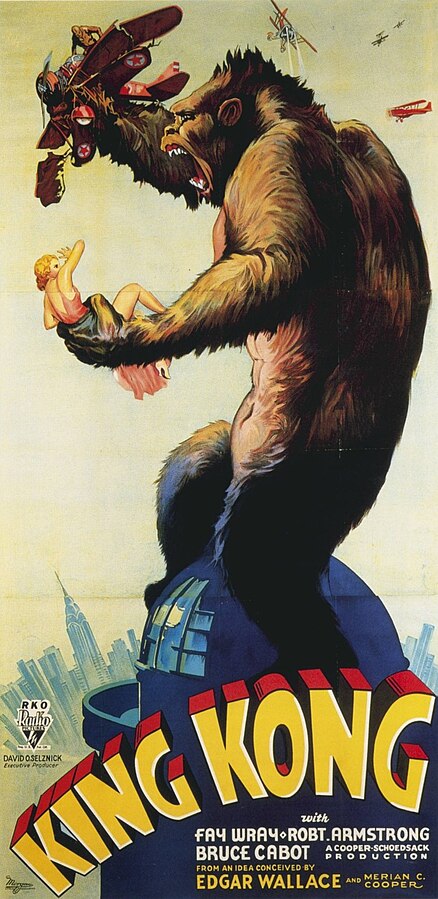
Exploring New Sounds: 1950s-1970s
After World War II and into the Cold War, film subjects became less romantic. They often told stories of criminals and detectives and nightclubs, or with science fiction films, reflected the fear of technologies like nuclear power. Jazz, dissonance, electronic instruments, and various experimental sounds made their way into the film score.
Bonus Video: Herrmann, Prelude from Psycho
Bernard Herrmann collaborated with film director Alfred Hitchcock for a number of pictures. In the prelude to the psychological thriller Psycho, Herrmann used dissonance to create a nervous tension, aurally preparing audiences for what’s to come.
YouTube Video: “Bernard Herrmann: Psycho – Prelude” by LM R
Bonus Video: Herrmann, The Murder from Psycho
Herrmann used shrieking dissonances to musically depict the action of the infamous shower murder scene.
YouTube Video: “The Murder” by Bernard Herrmann – Topic
Rock and roll and popular music became used in movies (Blackboard Jungle 1955, Elvis Presley’s films of the 1950s and 1960s, and The Graduate in 1967). Additionally, theme songs began to replace leitmotifs of films like those of Steiner, as heard in film series like The Pink Panther and James Bond. These theme songs also had crossover appeal and could 1) be sold as their own pop songs and 2) help promote the film.
The 1950s and 1960s also saw television shows emerge as a popular genre and the theme song as another need for music. Prominent themes of the time include the jazzy riffs of the spy show Peter Gunn, the spooky sounds (written by Bernard Herrmann) for The Twilight Zone, and the iconic theme of the original Star Trek. In a format where the story changed from week to week, the theme song provided continuity.
John Williams and the Return of the Orchestra
After a wide variety of new styles and sounds in 1950s and 1960s films (many of which are still prevalent today, like the collages of pop culture music in Quentin Tarantino films), John Williams emerged as one of the greatest film composers scoring films like Jaws, Star Wars, E.T. the Extra-Terrestrial, Indiana Jones, Superman, Jurassic Park, and many, many others. Like Max Steiner of Hollywood’s Golden Age, Williams used the large orchestra, harmonies, and recurring motifs found in works of Romantic period composers
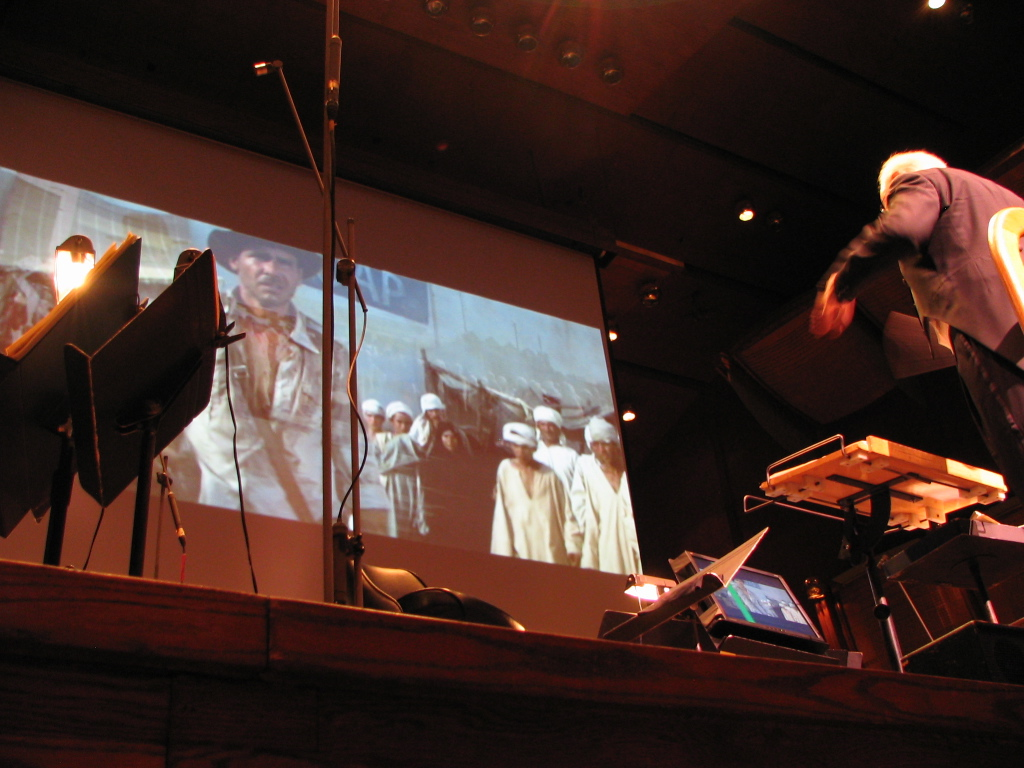
Bonus Video: Williams, Main Theme from Star Wars
This main theme opens with extravagant brass fanfare and includes a variety of melodies and themes: a recurring main theme that underscores much of the action in the film, militaristic music used for the Empire and Storm Troopers, music for outer space, and Princess Leia’s theme.
YouTube Video: “Main Theme from ‘Star Wars'” by John Williams – Topic
Joe Hisaishi: The John Williams of Japan
Hisaishi was born in 1950 in Nakano, Japan. He’s been musically active almost his whole life and attended the Kunitachi College of Music in Tokyo. Early influences included the electronic music band Yellow Magic Orchestra and American minimalism (which is discussed in Chapter 10). His alias is inspired by legendary American musician and producer Quincy Jones: “Quincy” is pronounced “Kuinshi” which can be written as “Hisaishi,” and “Joe” was derived from “Jones.”
While Hisaishi has worked in a variety of genres and styles, he is especially known for the soundtracks he created for the films of Hayao Miyazaki.
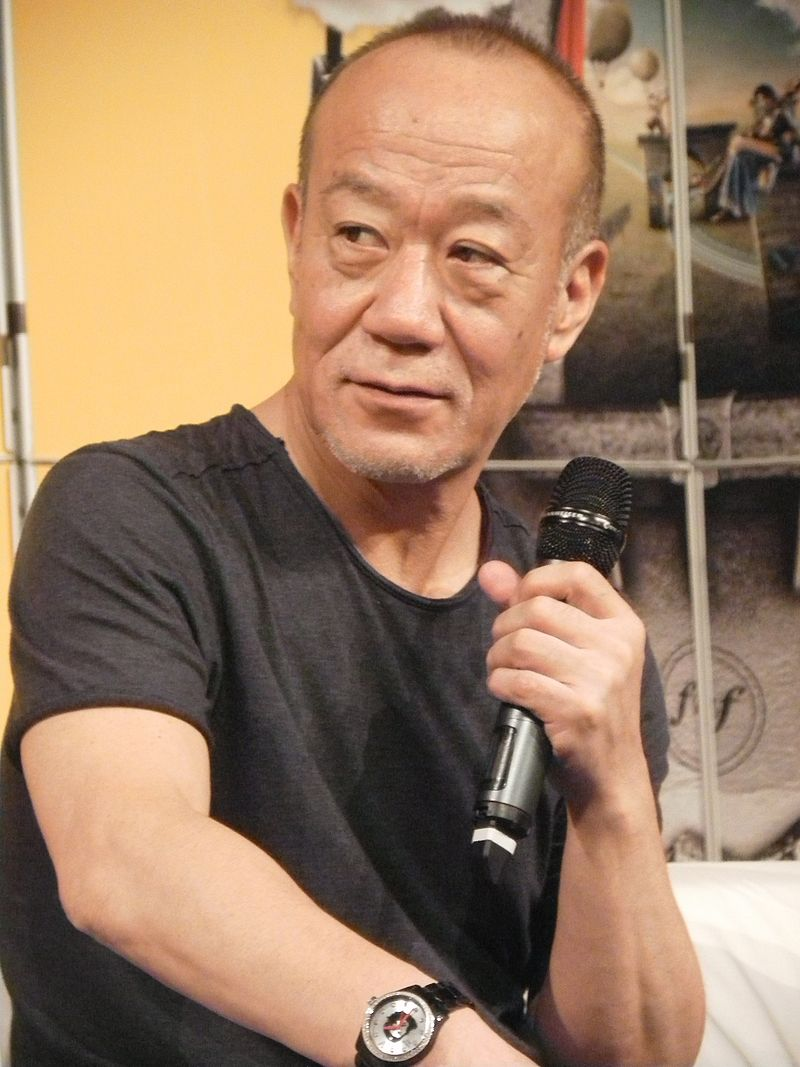
Bonus Video: Hisaishi, “Doves and the Boy / The Girl Who Fell from the Sky” from Castle in the Sky (1986)
Hisaishi originally wrote the music to Castle in the Sky for synthesizers, but he reworked the music for symphony orchestra, with the hopes that a film soundtrack with the conventional tone colors of piano, strings, and winds would have more widespread appeal. Hisaishi uses the instruments to create pictures that range from sparse and serene to grand to somber to whimsical.
YouTube Video: “Doves and the Boy / The Girl Who Fell from the Sky” by Joe Hisaishi Official
Bonus Video: Hisaishi, “A Haunted House!” from My Neighbor Totoro (1988)
This piece—and the soundtrack in general—is charming, playful, simple, and upbeat as children meet friendly wood spirits.
YouTube Video: “My Neighbor Totoro OST – 03 A Haunted House (Obake Yashiki)” by lemonteaisgood
Kristen Anderson-Lopez and Robert Lopez
Kristen Anderson-Lopez and Robert Lopez are a husband and wife songwriting team. Anderson grew up in New York and North Carolina; she loved theater from a young age. She aspired to perform on Broadway and fell in love with writing song lyrics. Lopez grew up in New York. As a child, he learned how to play piano and saxophone and began writing music; as he finished college, he hoped to make a career writing musicals.
Lopez won awards for co-writing the musicals Avenue Q and The Book of Mormon. Together, they co-wrote the award-winning songs from the Disney movies Frozen (of which their daughters provided voice parts) and Coco and the Marvel show WandaVision.
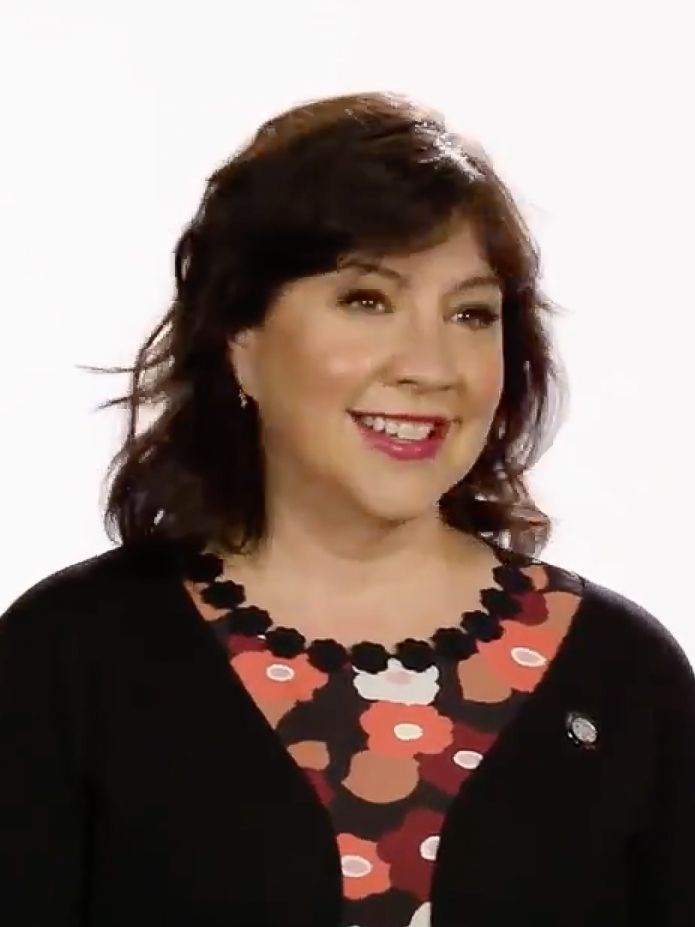
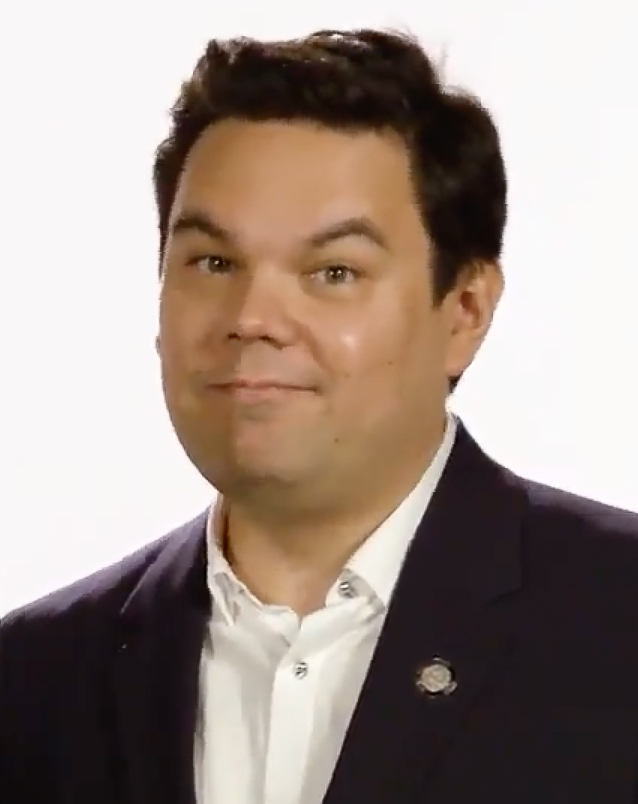
Bonus Video: Kristen Anderson-Lopez and Robert Lopez, WandaVision theme songs
WandaVision pays homage to various television shows and genres throughout the decades. Their songs were intended to “evoke all of the iconic songs from an entire decade and be their own thing.” Kristen and Robert contributed voice parts to these songs. They don’t usually contribute their voices to the final versions of their songs; this was partly due to the COVID-19 pandemic, but as they’re both accomplished musicians, their own voices worked for these recordings.
YouTube Video: “All Wandavision Intros / Openings” by fatevilpigeon
Video Game Music
Video games became especially popular in the 1970s and 1980s, being played in arcade cabinets, on consoles connected to a home television, and with computers. Listening to video game music and sounds through the decades aurally illustrates how the technology has evolved. Older games had simpler technology with simple sounds. As technology became more powerful, games began utilizing recordings of instruments and voices, and could even digitally emulate the sounds of rock bands and orchestras to a convincing degree. The in-game music is generally looped underscoring: background music that’s triggered by in-game events loops as long as the player remains in an area or level. Popular music was tied in the 1990s and early 2000s; Grand Theft Auto: Vice City impressed gamers and reviews in 2002 with its seven CDs worth of popular music from the 1980s which served as its soundtrack.
Koji Kondo: Super Mario and The Legend of Zelda
Nintendo hired musician Koji Kondo in 1984 to be their first employee who focused on creating primarily music (and not just sound effects) for their video games. He remembered, “I found my way to Nintendo by looking at the school’s job placement board. You’re supposed to apply to many different companies, but I saw the Nintendo ad, I had a love of making synthesizers and loved games, and thought—that’s the place for me. I interviewed with one company, Nintendo, and that’s where I’ve been ever since.” The next year, he created the iconic soundtrack to Super Mario Bros., looping and alternating between different sections of music to add variety while saving space on the limited cartridge. The next year, he composed the equally iconic main theme to The Legend of Zelda. While Koji Kondo originally worked with simple electronic sounds that may sound primitive today, as the technology increased, the sound samples became more advanced. Eventually, Super Mario soundtracks used live orchestras in combination with synthesized sounds.

Bonus Video: Koji Kondo, Super Mario Bros “Overworld Theme”
This fun, bouncy piece captured the feel of the athletic (at least by 1985’s standards) Mario running and jumping through obstacles. Koji Kondo rearranges four melodies into the form AABBCAADDCD to add variety to these repetitions.
YouTube Video: “Super Mario Bros (NES) Music – Overworld Theme” by GBelair
Bonus Video: Koji Kondo, Legend of Zelda “Overworld Theme”
This march-like piece plays as the hero traverses a fantasy world.
YouTube Video: “Legend of Zelda, The (NES) Music – Overworld Theme” by GBelair
Soyo Oka
Soyo Oka began working as a composer for Nintendo in 1987. She created music for the NES and is especially remembered for creating some of the most memorable soundtracks for games from the early Super NES: SimCity, Pilotwings, and Super Mario Kart. She began working as an independent composer in 1995, creating works as “DJ Alice.”
The following quotes are from an interview that Soyo Oka gave to Video Game Music Online:
During my childhood and early teenage years, my primary influences were Chopin, Rachmaninov, Debussy, and so forth.
I became aware of Western popular music after I entered high school. I listened to a lot of rock. At that time my idols were Queen! I had all of their albums, and went to see them live when they performed in Japan. Freddie Mercury was still alive at the time, and I was a fan of their guitarist, Brian May. I also liked The Cars and XTC, as well as Crossover, a predecessor of fusion.
Without giving too many examples, among Japanese artists I listened to YMO a good deal. BGM, one of their later albums, is my favorite. On the other hand, among Ryuichi Sakamoto’s solo work, I find the early Thousand Knives to be unforgettable.
I majored in composition at a music college. At this time, I would study classical and modernist music at school, while I was attracted to the world of synthesizers and multi-track recording as a hobby. It was enough of an inspiration to this simple girl just to have won a prize in a multi-track recording contest.
My first forays into computer music began with a simple setup: a composition program by Yamaha I installed onto my MSX, a drum machine, and a “Cat Food Can Mixer” I received from my friend who produced the sound. (It was a homemade mixer made from cat food cans, of all things.) The software could only handle up to eight voices at a time, so I had to supplement it with a manual multi-track recorder when more were needed. There was a studio that rented equipment that I could walk to in thirty seconds, and they had a public MTR, so I would often take the sequences I had written on the MSX over to the studio to reinforce them manually with the studio’s synthesizers.
Ice Hockey and Vs. Excitebike are among my earliest works. I found it unexpectedly enjoyable to compose under such limitations, confined to three channels and a noise channel. In places where the sound effects are more prominent, the game would often be programmed to cover over one part, so I had to think about composing such that one of the three parts could disappear without sounding unnatural, and how to compose something that would remain interesting, even at the times when so few sounds were left. Finding the tricks that would allow one part to serve two functions was very enjoyable work, like a sound puzzle.
I felt that SimCity was a very different type of game. I wanted to avoid giving the players any stress as they diligently built up a city. I desired to have a consistent musical environment throughout, without any feeling of an ending. I also wanted to reflect the growth from village to megalopolis musically, but not obtrusively. So I began by creating a simple motif (melody), and created variations fitting each piece, so that the music would develop from the simple to the grandiose.
Bonus Video: Soyo Oka, Sim City Soundtrack for Super Nintendo OST
During the gameplay, the same main melody is elaborated with different accompaniments as the development grows from Village to Town to City to Capital to Metropolis to Megalopolis.
YouTube Video: “SimCity Soundtrack (SNES OST, 24 Tracks) Sim City” by Lyra2
Nobuo Uematsu: Final Fantasy
Nobuo Uematsu taught himself to play the piano. He was influenced by pop singer/pianist Elton John. He began composing music for the video game company Square. Their Final Fantasy series became especially popular, and his compositions for the series are regarded among the best of video games from the 1980s and 90s. Like Koji Kondo, his soundtracks used simple electronic sounds initially, and as the technology improved, games were able to use better-synthesized sounds. Also like Kondo, symphony orchestras have performed his works in concert halls throughout the world.
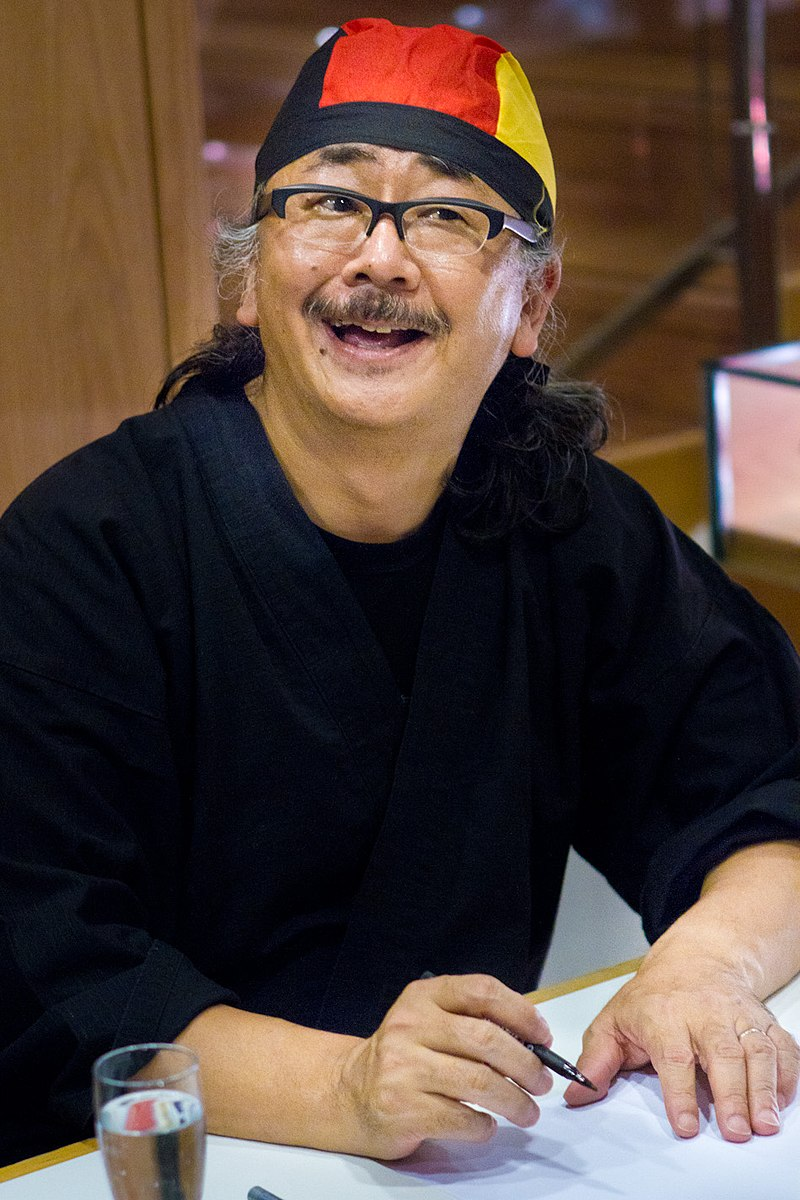
Bonus Video: Nobuo Uematsu, Final Fantasy preludes
This music arpeggiates a chord progression, playing notes of a chord one at a time. In future game installments, a flute melody was added. You can listen to the Prelude as it has appeared throughout the series here:
YouTube Video: “Prelude (final Fantasy Series)” by Nobuo Uematsu – Topic
Toby Fox
As a highschooler, Toby Fox created a well-known ROM-Hack, or modified game version, of the Super Nintendo classic video game EarthBound—“EarthBound Halloween Hack.” In his twenties, he created the now-classic video game Undertale. He used the website Kickstarter to raise money for the development. With the exception of some of the art, he created every component of the game: game design, writing, and music. Back in Chapter 6, we discussed how Richard Wagner was unique for creating so many of his operas independently—opera is usually a collaborative process. Video game making is also similarly collaborative, and Toby Fox is unique for creating such a successful and acclaimed game by himself (though advances in readily available technologies and retro aesthetics help make such solo pursuits more possible today than in years past).
When creating each section of the game, Fox, a self-taught musician, started by composing the music to help “decide how the scene should go”.
Bonus Video: Orchestre de Jeux, Music from Undertale
YouTube Video: “[OJV] Undertale – Live Orchestra” by L’Orchestre de Jeux Vidéo – OJV
Bonus Video: Toby Fox, “Megalovania” from Undertale
The piece uses “chiptunes” to replicate the sounds and aesthetics of early video games. As the introduction repeats, more parts are added, as it builds in intensity before a new and exciting melody appears. Additionally, as new parts are added, they sound more like recognizable instruments: guitar, bass, drums, brass – but still sounding like the processed sounds of older video games.
YouTube Video: “Undertale – Megalovania” by Game Guard
Additional Video Game Series
In addition to the above, a sample of game series especially commended for their music include (and are by no means limited to) the list below. You can find many of these soundtracks on YouTube.
- Animal Crossing
- Castlevania
- Fez
- Grand Theft Auto
- Halo
- Hollow Knight
- Metroid
- Metal Gear Solid
- PaRappa the Rapper
- Persona
- Pokémon
- Portal
- Street Fighter
- Silent Hill
- Shovel Knight
- Stardew Valley
- Tetris
Attributions
This chapter was adapted from the following OER:
- Understanding Music: Past and Present by N. Alan Clark, Thomas Heflin, Jeffrey Kluball, and Elizabeth Kramer from the University System of Georgia, licensed by a CC BY-SA 4.0 international license.
- Learn the Legends: Musical Performers of the Early 20th Century by Jamie Henke, Rich Freese, Moira Villiard, Sarah Korpi, and William Hagen from the University of Wisconsin-Madison Division of Continuing Studies, licensed by a CC BY 4.0 international license.
- Music: Its Language, History, and Culture by Ray Allen, Douglas Cohen, Nancy Hager, and Jeffrey Taylor from the Conservatory of Music at Brooklyn College of the City University of New York, licensed by a CC BY-SA 4.0 international license.
A type of folk song devised to help groups of people perform physical work. The music usually uses the tempo of the work itself and was sung by lumberjacks, railroad workers, and prison chain gangs, among others.
A song form used often in folk music, which is used to tell a story that usually contains a moral or lesson.
Theatrical entertainment in a club, casino, or restaurant. The audience is typically seated and is often eating or drinking.
A form of American entertainment that consists of singing, dancing, and telling jokes that often perpetuated racist stereotypes.
Early twentieth century recordings made by and for African Americans.
Money paid to composers for sales or performances of compositions.
Group of late nineteenth and early twentieth songwriters and music publishers who helped shape American popular music.
Written jazz arrangement.
Well-known early popular music songs.
An early form of country music, Hillbilly Music was an alternative to the jazz and dance music of the 1920s and was portrayed as wholesome music of the “good old days.”
Rock album with songs that follow a unified theme or idea.
Harmonically simple chords used in rock music.
Early theater with admission price of a nickel, or five cents.
Music that plays during film sequence.
Music that accompanies a film scene. Typically in the background to help set a mood or scene.
Background music that repeats.
Synthesized electronic music from or emulating sound chips.

